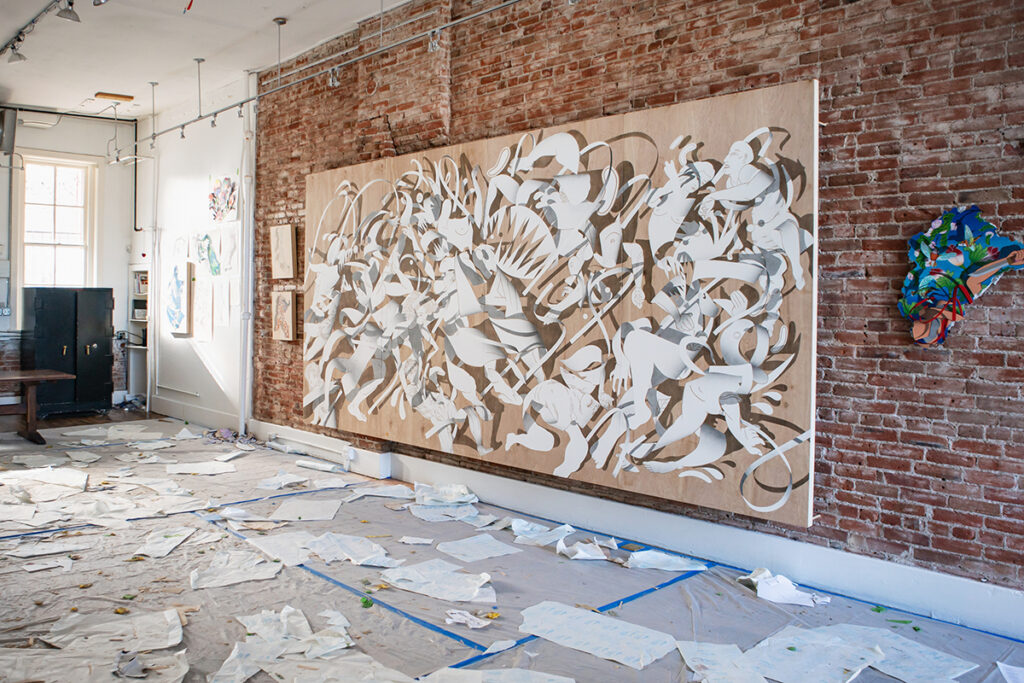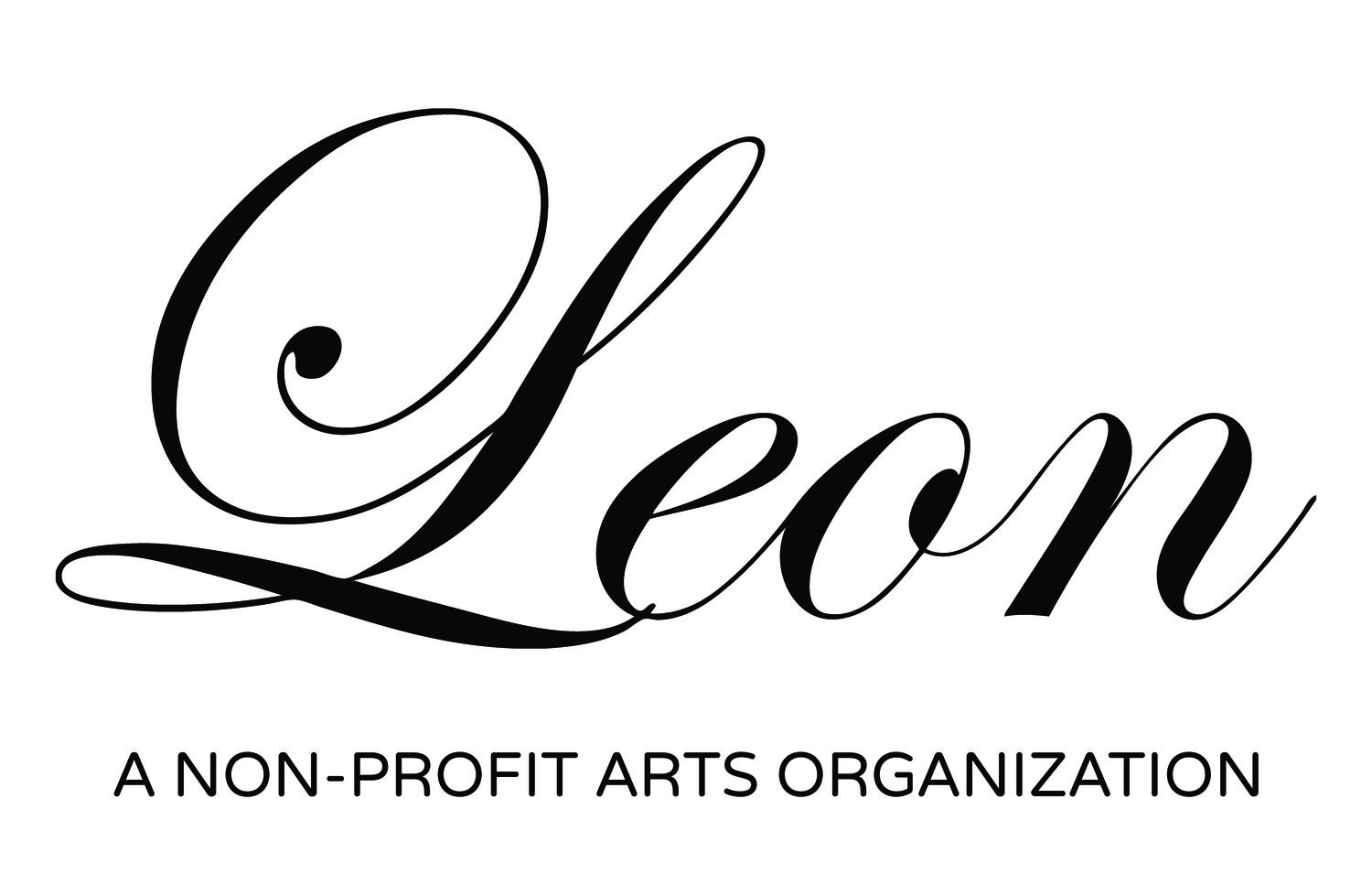Barth Quenzer is a visual artist, educator, and doctoral student who works for Denver Public Schools as an instructional curriculum specialist and believes good ideas should roam freely.

Entering Horror Vacui by Diego Rodriguez-Warner means to become witness to an unfolding artistic process. Nothing is hidden; everything is revealed. The remnants of art making (paper sketches, tape, cut outs, and debris) are left on the floor to be walked upon; the sound of plastic, wood, and paper with each step. In one corner, paint cans prop up a work-in-progress. Numerous sketches and paintings fill the walls. The small works-on-paper are held up by green painter’s tape and provide a backdrop for the larger masterworks.
Horror Vacui feels like you’ve stepped into the studio of the artist. Because of this, an immediate barrier between the artist and the viewer is broken down, a wall that often exists in order to hide the messiness of art making. The viewer, in this way, becomes a participant in the expanding and contracting universe of the artist at work. There is no way to avoid the mess, and no intention from the artist to hide it. If you want to see the work, the mess, too, has to be embraced.
It is impossible to experience the show without having a visceral reaction. Stepping on the debris of the art making while viewing the clean and orderly masterworks stirs something deep, primal, and emotional. Here, another barrier is broken down as the participant becomes intimately familiar with the artistic choices made to produce the work. Diego is doing something very vulnerable (even courageous) here by exposing his creative process. He is choosing to reveal his artistic secrets by allowing the participant to follow a trail of artifacts in the wake of artistic development.
While the work is composed of line, form and color, the actual essence of the work isn’t something easily described using the traditional language of art. It transcends. The works themselves are fictions, illusions, and paradoxes. Various kinds of characters inhabit the scenes, both native and interlopers. The images are held in suspense by a trick of magical realism and the figures float several inches off the surface. Like the moment before awakening, the works are held in perceptual limbo. They are ephemeral and ineffable. How does one attach words to something so fleeting, changing, and mysterious? In his own written words, Diego hints at the works’ poetic nature: “Erudite gestures of casual indifference, airy contentious groups, ruptured single figures, these crumpled anxious odalisques.” We don’t even have to understand what Diego is saying in order to fully appreciate the poetic voice at work. The paintings speak, so listen.
At its essence, Diego’s paintings are visual haikus. The paintings are held together, like the first and last lines of a poem, by generating a creative tension in the middle. To see the work means to play with paradox. Chaos and harmony, tension and release, violence and tranquility. Each work is a container for creative tension.
Horror Vacui,
At once, terrifying and beautiful.
Fear of emptiness.
And like the haiku, an underlying Japanese aesthetic permeates the work. But the dominance of the Western canon can also be detected. These two world views, the Japanese aesthetic and the Western canon, work together to do something highly unique in Diego’s work. It is as if all the art history books of the Western tradition, from classical to modernism, have been stacked upon themselves forming a tall tower of art babel. Then, at the moment of its collapse he eviscerates the Western canon, cutting through the babble, scattering the pieces, rearranging them, and in the process reinventing art.
The poetic nature of the work weaves its way into the curatorial fabric of the show. Clues are planted here and there, both as signposts for directing one’s attention and also as provocations for dialogue and critique. The first clue appears upon entry, a small sculptural piece on the wall of purple foam core, paper, and pins. This little maquette tells the story of how the works came to be. The maquette is the “sketch” for the work, and in this case Diego playfully layers images and uses pins to hold in place paper ribbons that are folded like möbius strips. From here, the larger works take their content and form. The ingenuous process is a critical clue to decoding the masterworks.
Another important clue is planted next to an orange pleather couch where several books are stacked. The book on the top says, “Guernica.” The other books include works from Arturo Herrera, Matisse, among others. The parallels between these art worlds and Diego’s work can be immediately drawn. Directly across from the orange couch is ‘The White Painting,’ Diego’s personal Guernica, the show’s largest and most demanding piece. It is violent, perverse, and beautifully ethereal. Color is absent from this work which puts even greater emphasis on the magic of the painting. It is impossible to describe the work because the painting acts as an event, an epic being played out with an uncertain beginning and unknown ending.
But the story being told in Horror Vacui is not one of despair. Far from it. Diego’s indigenous roots as a printmaker apprentice in Cuba also permeates the works. It is a colorful spirit full of youth and vitality. Fear of emptiness is actually the invitation to play on the edge of the known and peer into the lifegiving possibility of the unknown. What we find on the lifegiving edge of the unknown is magic and bewilderment, horror and wonder. And this is exactly what Horror Vacui invites in its participants; a stepping into the mess of reality and persisting through it with a sense of equanimity… composure within the eye of the storm.
The importance of this work resides in its ability to direct our outer realities to an inner reality. There are social, political and cultural battles being waged in the works which quickly become the mirrors for our internal battles. Diego explains a kind of “collective chrysalis” that we are pushing through. The metamorphosis points to a creative transformation of the self and spirit. A great work of art activates our sense of self, while simultaneously transcending that self to remind us of our shared humanity. Ultimately, artwork must humanize us. Horror Vacui is an intellectual and artistic challenge to undergo humanization, a type of transformation that is difficult yet essential. In his words Diego expresses, “It is my hope that you find me as I am… somewhere in the gesture.” There is no doubt, we have found Diego as he is, and quite likely have found something of ourselves as well.
